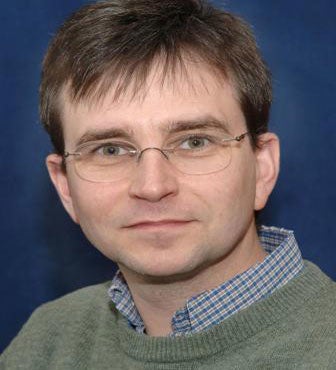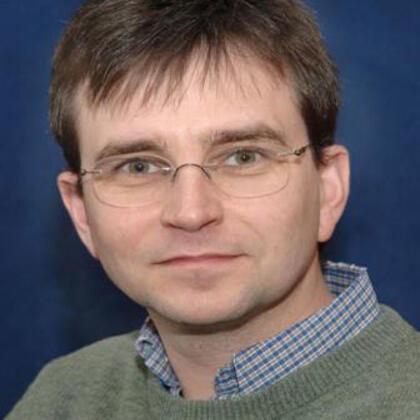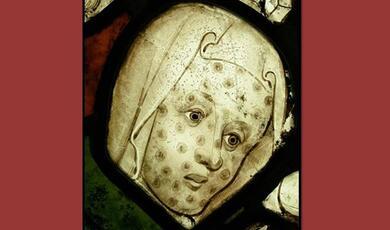Lord Kelvin and the French 'F' Word: The Greatest Victorian Scientist?
Share
- Details
- Text
- Audio
- Downloads
- Extra Reading
Lord Kelvin (1824-1907) was Professor of Natural Philosophy at the University of Glasgow from 1846 to 1899. An FRS, FRSE, knighted in 1866, awarded the Order of Merit in 1902, and in death buried beside Newton at Westminster Abbey, Kelvin was in his lifetime considered the pre-eminent natural philosopher of the Victorian Age. But the passage of time, and the supplanting of classical physics, have eroded his reputation. This talk will survey Kelvin's life and work, and seek to show why the assessment of Kelvin's importance by his contemporaries was not misplaced.
Download Text
31 October 2012 Lord Kelvin and the French 'F' Word: The Greatest Victorian Scientist? Dr Mark McCartney A queen with a reign of over 60 years. Grumpy scientists having public debates with senior clerics. Physicists who are famous enough to be household names. Scientists unifying the forces of nature (Salam, Weinberg and Glashow got the Nobel prize in 1979 for unifying weak and EM forces). A communications network which allows virtually instantaneous contact across the globe and other scientists proposing a theory of the ultimate building blocks of the universe based on something like loops of string. Ladies and gentlemen of Gresham College. Welcome to the 19th century. I will not mention the grumpy scientists and clerics (Wilberforce-Huxley debate of 1860). Later today we will hear about the Victorian theory of everything – based on knots in the ether when Julia talks about Peter Guthrie Tait and Raymond will tell us about the man who gave us the unified field theory of EM (James Clerk Maxwell). Though of course all three men knew each other well, corresponded often and worked on similar topics (heat, light, magnetism, electricity, vortex atoms). Peter Guthrie Tait & William Thomson co-authored a famous book, and Peter Guthrie Tait and James Clerk Maxwell went to school together, and when William Thomson built his large house outside Glasgow – James Clerk Maxwell provided peacocks for the garden! I however, want to talk about a scientist who was, in his lifetime the most highly regarded natural philospher in the country – William Thomson (and along the way we will talk about his role in the Victorian version of the internet – the Telegraph). The French F work in the subtitle is to add an element of mystique and suspense to the talk. What could it be? Might it be rude? This recording dates from the early 20th century, Kelvin is speaking about the radioactivity of radium. He was concerned about where the energy came from – and attributed it to thermal motion placing electrons in a ‘loaded’ state to be ejected from the atom. Other subjects in the series were Priestley, Huxley and Dalton. The biographer was Andrew Gray – Kelvin’s successor in the Chair of Natural Philosophy. In fairness though he was born in Belfast the Thomson’s great-great-great grandfather had moved to Ballynahinch on Co Down around 1641 at the tail end of the Ulster Palantation – from Scotland. William Thomson was the fourth of seven children. His father taught mathematics at Belfast Academical Institution – at the time a school and college combined. William’s father was highly motivated and hard working. He would rise at 4 am to work on writing his textbooks – on a range of topics including calculus, trig & geography. William Thomson’s mother dies in 1830 - never recovering from the birth of Robert in 1829. This perhaps made a move back to Glasgow in1832 more likely. William Thomson’s mother have come from Glasgow – and thus there were family (notably her sister) who could help with raising the children. However the primary cause for the Glasgow move was William Thomson’s father being appointed Prof. of Maths at Glasgow University (1832). Ten is young – but not that young. Fourteen was the minimum age for matriculation at Glasgow. However William, and his elder brother James who also enrolled (twelve) had been attending their father’s Junior Mathematics Class since 1832 (aged eight and ten respectively). William was precocious! A good example of this is reading Fourier. Fourier is in red because I consider reading Fourier to be a pivotal moment in William Thomson’s life. Jean Baptiste Joseph Fourier (1768-1830) was, you will not be surprised to hear, a French scientist & mathematician. In the analytic theory of heat he presents both the heat equation to describe heat flow through a body and the idea, which we now call a Fourier series, whereby any reasonably behaved mathematical function can be written in terms of a possibly infinite sum of sine and cosine function. This is noteworthy, not just because it shows high mathematical ability, but also because Fourier’s work was a constant intellectual companion and source of inspiration to him throughout his life. Thus to quote JJ Thomson again “… I have heard him [i.e. William Thomson] say …that whenever he had done anything with which he felt particularly pleased, Fourier’s theorem was always at the bottom of it.” SP Thompson states: “About certain branches of mathematics he was always enthusiastic. In praise of Fourier’s “mathematical poem,” Théorie Analytique de la Chaleur, he never tired”. Or finally there is PG Tait’s blunt and direct assessment “Fourier made Thomson”. And William Thomson did make much use of Fourier in his work – on calculations on the cooling of the earth, telegraphy and tide prediction, and we will look briefly at telegraphy and tides later. Jean Baptiste Joseph Fourier 1768 – 1830 William Thomson claimed that Philip Kelland, the Professor of Mathematics at Edinburgh was wrong in his criticisms of Fourier (in The Theory of Heat (1837). Kelland had been senior wrangler & smith’s prizeman in 1834 & was tutored by Hopkins Kelland had been quick to dismiss Fourier – it seems misreading him. Perhaps not too unreasonable as Fourier’s presentation was a little loose. Although initially incredulous of his son’s claims, a closer examination showed that they were accurate, and Thomson wrote the matter up in what was to be his first published paper which appeared in May 1841 in the Cambridge Mathematical Journal, with the author simply designated as “P.Q.R.” Picture is from Edin Uni Tercentenary volume Quasi Cursores (1884) Note James David Forbes on left – taught James Clerk Maxwell (‘I loved Forbes’) & Peter Guthrie Tait – as did Kelland Carlyle at the bottom was rector. When William entered St Peter’s college in Oct. 1841 he had already taken the full curriculum at Glasgow, had sat the exams, but did not take the Glasgow degree. Hence he around this time styled himself BATAIAP. William Thomson was tipped to be Senior Wrangler in the final exams at Cambridge virtually as soon as he walked thru the doors of St Peters aged sixteen. During his time at Canterbury, he published twelve papers (nearly all under the pseudo name PQR). Most on electricity and heat – some independently reproducing work by Sturm, Gauss & Green – ie it was good stuff! William Thomson worked hard – but also had a very full social life. He rowed and was a founder member of the CUMS. The Mathematical Tripos was the most grueling academic race course in the country, and Hopkins trained and honed his candidates well. Thomson’s examinations commenced on New Year’s Day 1845, and finished on the seventh of January. There was a high proportion of ‘bookwork’ based questions and the papers required fluent recall, a good knowledge of mathematical tricks and shortcuts, and fast penmanship. To universal surprise when the results were read out Thomson came second, with one Stephen Parkinson, a student at St. John’s, coming first. One explanation for Parkinson’s victory is that, quite simply, he wrote much faster that Thomson. Indeed one of the examiners commented that if he had not seen Parkinson’s speed in the examination hall he would have struggled to believe that the sheer volume of material could have been written by him in the time limit. However, when it came to the Smith’s Prize examinations later in January Thomson easily took first place. These papers were more heavily weighted towards problem solving, and Thomson outperformed Parkinson in each of the four papers, and in two of the papers the marks were in the proportion of three to two. The image comes from an album of forty-two portraits of William Hopkins’ top wranglers, done mainly by Thomas Charles Wageman. If you want to read more about these portraits and the men behind them – then read Axex Craik’s Mr Hopkins’ men. His election to the Glasgow chair – though unanimous was not inevitable. William’s father had been watching the declining health of previous professor of nat. phil. carefully, and ensuring William Thomson got appropriate experimental experience at Cambridge, and in the chemistry labs at Glasgow one summer, and going to Paris post graduation for 4.5 months working in Regnault’s lab. James T, as a moderniser in Glasgow, was not popular with other faculty members. Appointing William Thomson was appointing one more vote for JTs ideas. At least one professor said he would rather see Satan appointed to the chair of natural philosophy that see it given to Willaim Thomson. In the event, however, Satan did not apply. The second pivotal event is Thomson’s knighthood in November 1866 – this may be seen as signaling the apex of his career. The knighthood resulted directly from Thomson’s heavy involvement in the laying of the transatlantic telegraph cable. This is Victoria’s diary entry after visiting the Crystal Palace & seeing telegraphy demo-ed. By the time Victoria saw this demonstration, telegraphy was already established over land. Cook & Wheatstone had gone into business in 1837 in England, Morse in 1840 in America. Indeed in 1851, the year of the Great Exhibition a line was laid between Dover & Calais. Also on display was an electromagnet made by Joule, which could support a ton! The Atlantic Telegraph Company had been formed in 1856 with William Thomson as a director, with no scientific role. However by 1857 he is on the ship Agamemnon (the other ship was Niagara). The 1857 attempt fails. 1858 – another attempt – which worked for about two months. At this point the share value collapsed, and it was not until 1865 that it was attempted again. Again there is failure. The cable broke 1250 miles out 1865 – failure three attempts to grapple failed – cable breaks 1250 miles out. However, 1866 – success & last years cable found & fixed – so two cables cross Atlantic. In 1865/6 new heavier cable had been produced (1.7 ton/ naut mile) and the Great Eastern had been bought to lay the whole cable. When built by Isombard Kingdom Brunel in 1858 she was the largest ship ever built! One of the issues with the telegraph was how a signal ‘spreads’ as it propagates along the cable. A sharp pulse at one end arrives as a gentle hump at the other. That not only makes it hard to detect but means that the pulses ‘merge’ into each other – slowing down how fast information can be sent. The ‘correct’ telegraph equation was written down in 1876 – note the equation William Thomson uses! He ignores self-inductance and gets the mathematical equivalent of the heat equation! ie Fourier! Stokes was a little concerned by this - but William Thomson’s physical intuition was good – it was enough He could approximate spreading was proportional to both R & C – both proportional to the length of cable L, therefore signal spreading was prop L^2. Further spreading could be reduced by decreasing R and C – ie increasing the cross section of the Cu wire and increasing the thickness of the insulating gutta percha sheath. It was an excellent bit of mathematical modelling – William Thomson realised the self inductance was not crucial. Writes this down in a letter to GG Stokes in 1854 – but it is not published until 1855. His work on the cable formed fertile ground for his science and entrepreneurship. Not only were there the direct results of papers on electricity, the development of new equipment (such as the mirror galvanometer) and patents and wealth, but Thomson also got a taste for life at sea. This resulted in the purchase of a 126-ton yacht (bought 1870) and a whole series of papers and patents on maritime issues. Thus in the 1870s and 1880s he gave over 50 papers and talks on matters such as the tides, compass design, lighthouse signaling and depth sounding. What are the tides? – they are nearly periodic rise and fall of water levels. Why are they important? Well if you are running an Empire you are moving your goods around by sea in big ships. By 1830 there were over 1000 ships a month coming up the Mersey to Liverpool– and two or three of them were so big they could only do so around high tide. Kelvin, along with the help of his brother James (by the 1870s Prof of Engineering at Glasgow) automated the whole procedure of tide prediction. He develops three devices. To record the tides over a number of days (say a couple of weeks). The magic trick is to write the height of the tide, H(t), out as a series of sine and cosine waves – like a Fourier series. Kelvin had H(t) graphically from the tide gauge, and all the w’s – all come from the periods of rotation of the moon, sun (for the first two terms) and then various corrective terms to account for the moon’s elliptic orbit, precession, etc. Kelvin included five such terms (which meant ten integrals plus one for mean water height). Calculating the As & Bs would then give you the form of H(t) and then you could calculate it’s value out in advance by any amount of time you pleased. The As & Bs would be different for each port and would depend on local coastal geography and sea depths etc. The harmonic analyser evaluated the co-efficents of the sine & cosine terms Finally the tide predictor used the co-eficients to predict future tides. His tide predictor could crank out (quite literally) a years tides for a port in twenty-five minutes. None of the technology was completely new – each of the devices built on earlier work, but it is an excellent example of Thomson’s fecundity. The first physics lab was in Glasgow circa 1850. In later years labs at Oxford, UCL, Liverpool, Canterbury would be modelled on it. In terms of thermodynamics William Thomson was one amongst many who worked on the area. I think if asked for a one line view I would say Clausius gets priority for law II (1850 – with William Thomson getting there in ‘51) and Helmholtz for CofE in ‘47 (privately published). Regarding new universities he supported Owen’s College (Manchester) the Queen’s College’s in Ireland, Liverpool, Birmingham. Kelvin wrote in 1907: “I remember the Times saying that Sir William Thomson was so fond of universities that there could not be too many of them.” Key to placing c of e centre stage is T&T’. C of E as a pedagogic unifier in physics definitely belongs to T&T’. In the preface, T&T’ give the honour of the discovery of con of energy to Joule – but also claim it goes back to Newton – this not only gives the discovery a good British provenance, but also sets T&T’ as the NT to Newton’s OT – complete with a fulfilment of his veiled prophetic words re conservation of energy. It was C of E which enabled the reorganisation of physics and hence the world around it by the end of the 19th century.. In 1861 Tait was thinking along the lines of a three volume complete course in physics but T&T’ was a project never completed. The second ed. Of 1879 was enlarged, but not to include optics hydrodynamics and electricity and magnetism – it remained a book focussed on kinematics and dynamics. When William Thomson became Lord Kelvin the British Medical Journal wrote “A Peerage has at length been conferred upon a scientific man because he is a scientific man.” The BMJ might have liked to think so, but he would not have got it had he not been actively supporting liberal unionism over the previous six years. That said – all the 438 letters of congratulation, which William Thomson got – felt it was for his science and technology. Interestingly one of the reasons gave against Home Rule for Ireland was that it was unnecessary as Dublin and London could communicate so harmoniously via telegraph! Burial in the abbey beside Newton is significant. He is laid to rest beside the other great of British Natural philosophy. And it is not just a memorial stone or ashes (as it is with many others). Indeed when I spoke to the librarian in the Abbey he expressed surprise that William Thomson was physically interred in the 20th century – as this practise had been stopped before that date. There are statues in Belfast & Glasgow. This is the unveiling of the Belfast statue by Sir Joseph Larmor in 1913 – another Irish mathematical physicist who had replaced GGS in the Lucasian chair at Cambridge. William Thomson had an excellent grasp of both mathematics and physics and engineering. He had and enormously creative mind. In his lifetime he published over 660 papers on a vast range of topics. He was also hugely entrepreneurial – taking out 70 patents, going into business with his Glasgow instrument maker. He was not afraid to make money, and he made lots. He was also simply an enthusiast - it seems whatever came across his path could absorb him, and as JJ Thomson said of William Thomson in 1924 on the centenary of his birth; ‘To be interested in something was, with Lord Kelvin, synonymous with discovering something new about it.’ He was a remarkable, fascinating man. But, today, there are two more to come. © Dr Mark McCartney 2012
This event was on Wed, 31 Oct 2012
Support Gresham
Gresham College has offered an outstanding education to the public free of charge for over 400 years. Today, Gresham College plays an important role in fostering a love of learning and a greater understanding of ourselves and the world around us. Your donation will help to widen our reach and to broaden our audience, allowing more people to benefit from a high-quality education from some of the brightest minds.


 Login
Login








